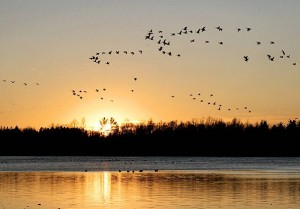Parcels in the eastern part of the park, between the 209 acres Beaver Lake and East Mud Lake Road, were owned and farmed by the Goodrich, Colling, and Krupka families. Tobacco, potatoes and corn, and later peonies, grew where mature forests stand today. Fruit crops, strawberries especially, flourished south of the lake. Cows grazed among the trees on what is now the Hemlock Hollow Trail. Water was drawn for irrigation from the dredged channel alongside the Bog Trail.

In the 1920s and 1930s, Judge Irving D. Vann of Syracuse consolidated large holdings around the lake. He allowed farming to continue northwest of the lake while establishing a waterfowl refuge on the rest of his property. He planted sago plant and wild celery and stocked the lake with resident wing-slipped geese and ducks to attract migrating waterfowl. During his stewardship, flocks of 1000 or more geese visited during spring and fall migration. Hunting and fishing were allowed with permission during these years, but predators were actively discouraged. Hawks, owls, and foxes were shot, and snapping turtles trapped. Turtles as large as 27 pounds were reported trapped from the lake.
Judge Vann died in 1944, and his property was sold to Frederick and Winifred Fuess, who continued protective stewardship of the property. In 1955 Mrs. Fuess, then widowed, sold a conservation easement on the property to the NYS Conservation Department for use as a waterfowl refuge. IN 1963, Onondaga County acquired all but 10 acres of the Fuess property together with all but 4 acres of the Krupka farm to the south, for use as a future park. The purchase of some 400+ acres was effected with a 75% contribution of state funds from the 1960 State Parks and Recreation Land Acquisition Bond Act. The county quickly established plantations of Red Pine, Norway, and White Spruce, and Japanese and European Larch to reforest the farmland east of the lake. The next several years saw controversy over plans for use of the site. Strong pressure was brought for the development of the Beaver Lake property for picnic grounds, ball fields, fishing, and swimming. The National Audubon Society Nature Center Planning division conducted a study, which recommended that the resources were not suited to those uses, but were ideally suited for nature education and passive recreation.
The newly founded non-profit organization, Onondaga Nature centers, Inc. designed the first 5.3-mile system, together with interpretive signage and booklets for seven color-coded trails through the varied habitats on the property. With the construction of a roadway, parking lots, maintenance garage, and a toilet building, Beaver Lake Nature Center opened in 1970. By its second year of operation, Beaver Lake Nature Center was serving 70,000 people per year. Year-round programming began with the opening of the current Visitor Center, which was built over the existing toilet building in 1974. Before that time, Onondaga Nature Centers provided school tours and limited public programs from April 15 through November 15.
Onondaga County took over full operation of Beaver Lake in 1977, and trails have been adjusted, rerouted, and expanded gradually since that tie. A critical feature of Beaver Lake Nature center’s development has been the financial support and volunteer service of the Friends of Beaver Lake, Inc. The Friends group was founded in 1980 and began at once to raise money to supplement County funding. Beaver Lake has a membership program, whereby tax-deductible dues entitle a member to free admission, a subscription to the quarterly newsletter, Beaver Tales, and discounts on program fees.
Through the commitment of Onondaga County, staff members, and generous volunteers, the people of Central New York have been provided a rich opportunity to experience, enjoy and learn about the flora, fauna, and ecology of their region.
